Art and Mental Health Interview with Illustrator Sue Clancy
The power of art to overcome challenges and fight injustice, the value of creative process over product, and feeding the good wolf.
I am so thrilled today to have an interview for you with artist Sue Clancy. She previously interviewed me about my book The Artist’s Mind for its virtual tour, and I really enjoyed our conversation. Now I get the chance to return the favor after taking some time to sit with Dr. Bob's Emotional Repair Program First Aid Kit, which is one of the books she is proudest of having illustrated. We also discuss her history as an LGBTQ+ deaf female artist growing up in a religious-conservative culture, how art and some great people helped along the way, and some of the transitions she’s experienced in how she sees the value of her artwork as a process in her life.
Hi Sue! What are you thinking/feeling as we begin this conversation about art and mental health, the book you illustrated for Dr. Bob, and some of your other creative work?
One of the chief things I’m feeling as we begin our conversation is sunburnt and tired. My wife of 27 years and I spent a spontaneous fun day yesterday outdoors at the Portland Japanese Garden. We had lunch at one of our favorite restaurants and walked to some art supply stores! It was a grand day and despite using sunscreen and hats I got some sun. We walked almost 6 miles!
Oh that sounds like such a wonderful day! I love Japanese Gardens, although I remain a bit partial to ours here in San Francisco. Ouch on the sun though!
My feelings about talking with you about the book, Dr. Bob’s Emotional Repair Program First Aid Kit, that I illustrated for Dr. Bob Hoke: happy as it’s one of the projects I’m most glad I’ve done. It has stuck with me and grown with me since it began. What I learned by doing this book has become a part of every other creative project I’ve done.
I really enjoyed the book and was excited to learn from it after you sent me my copy recently. We’ll talk more about that shortly, but first … can you tell us a little bit more about your journey as an artist?
My journey as an artist? Well some of my earliest memories are of sitting at my grandmother’s round oak dining table drawing. Grandmother kept a chipped ceramic mug with pens and pencils in it next to a stack of mimeographed sheets of paper that had a blank side for me to draw on. My biological parents were very religious and they and their church disapproved of my “graven images” – which at that time were my childish drawings of ducks, cats and dogs. But I lived primarily with my grandmother so outside of my once a month weekends with my biologics I was free to draw what I liked so I did. Grandmother’s house had 3 homecooked meals, regular bedtimes and trips to the local library – and that treasure trove of pens and pencils. The library was another thing my biologics frowned deeply upon. But Grandmother and I stopped by the library almost every day as we walked to and from where she worked. Whenever we were at home she encouraged me to draw, to read and to go outside and play. Her primary rule was “be home by dark”. If I wasn’t at the table drawing, I’d put paper and a pencil in my pockets and roam around the neighborhood drawing things. Often, if I wasn’t drawing, I’d be sitting up in the pear tree in Grandmother’s backyard reading one of the library books.
I love your grandmother already for encouraging you in this way. It sounds like a really reparative and wonderful opposite to your experience with the “biologics.”
My “visits to hell” as I called the weekend stays with my biologics didn’t have much in the way of meals. Drawing, dancing, climbing, running, visits to friends, reading anything other than the bible were all absolutely forbidden. As I grew up, drawing and reading were increasingly my two main lifelines. My bio-mother had pushed me down some stairs when I was about 5 years old and I became deaf from that event (and moved in with Grandmother). So, reading books was one main way that I learned about the world. I didn’t get hearing-aids until age 8 when both of my grandmothers put two and two together and figured out that I needed hearing aids. Hearing aids and speech therapy were also disapproved of by my biologics. So, both of my grandmothers creatively worked around that. The grandmother I lived with died when I was 13 years old so I went back to living full time with “the biologics” – insert dumpster fire here. I continued drawing and reading and sneaked around to make my art despite their vocal disapproval.
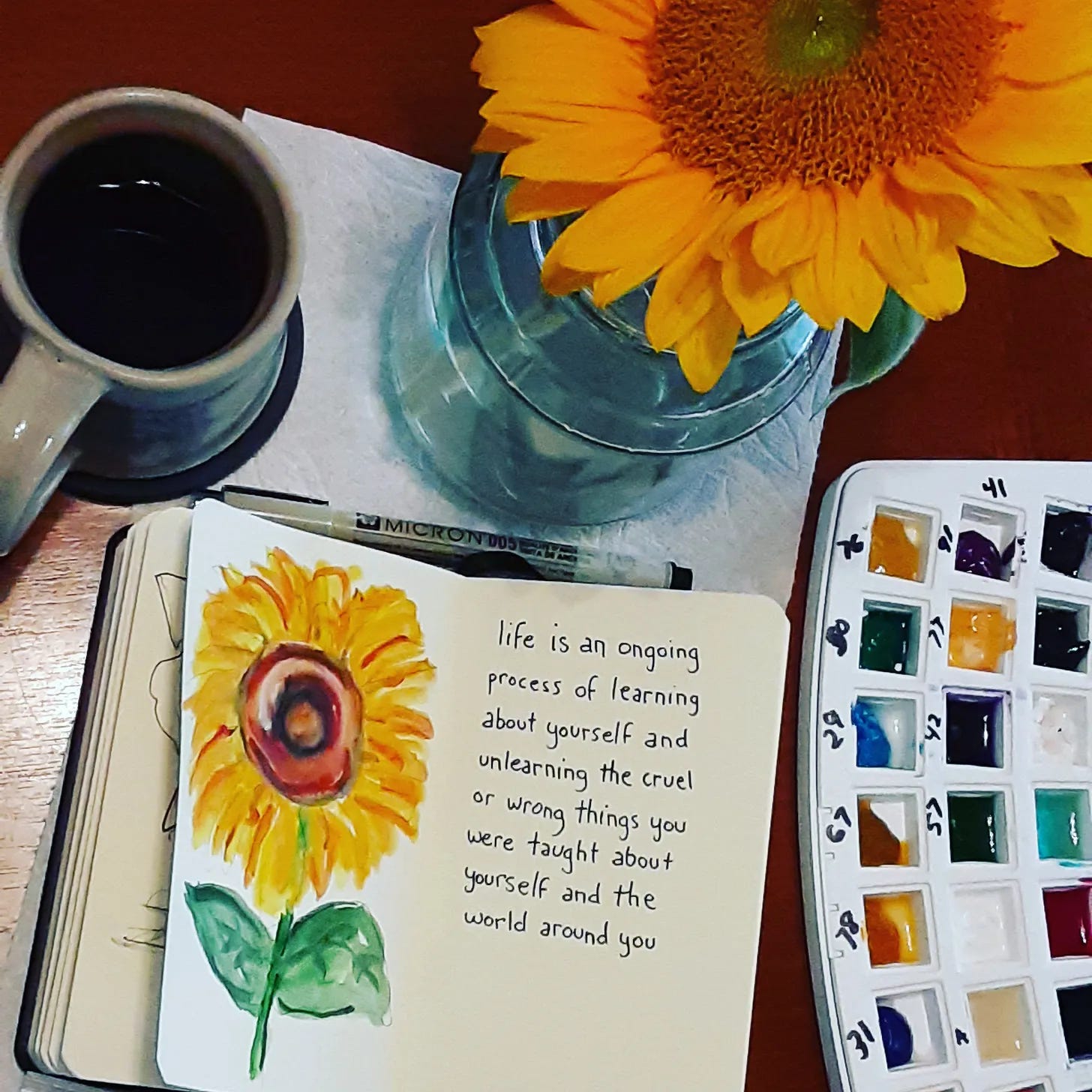
I am so sorry that you experienced that loss of such a critical person in your life at such a tender age. But also so glad that you had her in the early days.
Fast forward to age 15 when I began talking with teachers at my public school about going to college. I mentioned this to my biologics and they were extremely angry. It turned out that they had already picked out, and made arrangements with, a much older man from their church to marry me before I finished high school. I absolutely refused to do that and came out to them as a lesbian. Insert Jerry Springer style dramatic 5-alarm dumpster fire - with violence - and they kicked me out of their house. Somehow, at age 15, I had the presence of mind, in the midst of the arguments, to get a black plastic trash bag and grab some of my belongings including my birth certificate and other things I knew I’d need when applying to college. Within about 3 blocks, walking with my bag over my shoulder I felt tremendous relief even though I had no clue what I was going to do next. What I did was couch surf with my public-school friends for the next few years and made money by doing illustrations, advertisement designs and even window decorations for retail businesses. One of my favorite regular “gigs” was to handwrite and illustrate a daily menu for a local bakery and café in exchange for money and or meals. During all of that I applied, with valuable help of my public-school teachers, to go to the college of fine arts at the University of Oklahoma… the biologics were incandescent with rage … and I began college the year I graduated high school while living in my car. I graduated from the University with a BFA in 1992.
So, I’m proud of not just surviving but going on to thrive! I’m proud of those efforts to make a living via my art even when I was a high school kid. I’m proud of graduating college. I’m proud of persisting in being creative. I’m proud of continually learning about creativity, mental health and being a fully human being.
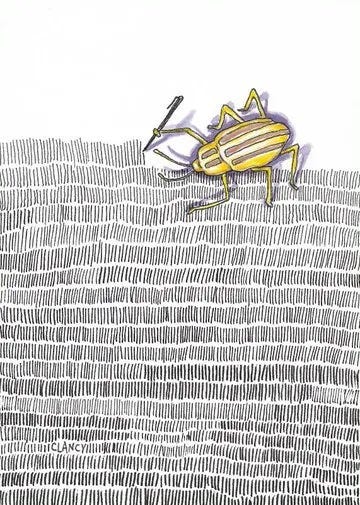
You should definitely be proud! That’s a lot of trauma to cope with in childhood and I love that art played such a positive role for you throughout. When you mentioned being kicked out of the house as a teenager and making money with your drawings, I thought of Basquiat … of course, his story is very different from yours including how he made his money at that time but this resilience of artists from diverse backgrounds, including their creativity in youth, never fails to amaze me.
I fully believe that what happens to us can’t be the continual focal point of our lives; rather it's how we respond and what we choose to do next. We can acknowledge "this hurts" and then continue with our chosen flow of our life. We have to choose to see, hear, value and accept gifts from the amazing people that are already in our lives. Here’s a story online that I believe illustrates this:
I love that. And it relates to some of the stories in the Dr. Bob book … but before we talk about that, let’s talk about a few of your other projects. One of the things you mention on your website is that your art has been in hospitals ... I'd love to know more about that. (Hospital Rooms, which brings art to mental health inpatient care, is one of my favorite projects to follow, and I want to see more and more of this in the world.)
Art has been a solace for me all of my life thus far so I have sought to do public art projects that would place my art where there were people, particularly young people, having difficulties. One of my early public art projects, long ago now, was for The Beth Israel Deaconess Hospital in Boston Massachusetts. I did a short series of colorful narrative paintings for their children/young adult area. More recently I was commissioned to do two large scale diptychs for the Curtis Children’s Justice Center in Vancouver Washington. I’ve also done commissions for the NW Surrogacy Center in Portland Oregon, for CARF International (Commission on Accreditation of Rehabilitation Facilities) in Tucson Arizona, for the Youth and Family Services of El Reno Oklahoma and for the Infant Crisis Services of Oklahoma City to name a few of my hospital, healthcare and justice related projects.
Wow. That’s such wonderful work. What other work are you doing that you want us to know about?
When the pandemic began in 2020, I was able to work with Storyberries – a book distribution company that provides free e-books for children of all ages. As of this writing I have 20 books there that I’ve authored and illustrated. I view this as a variation of the hospital, solace of art, ongoing project.
Note: Sue’s book The Professional Dog recently made the Storyberries top 10 alphabet book for kids list!!!
Yes, and also a variation on libraries which as you’ve mentioned were important in your childhood. Okay, let’s talk more about the book you illustrated for Dr. Bob. I’ll grab us a couple of cups of coffee and we can dig in …
First, let’s tell the readers a little bit about the book. It’s a slim book that includes a series of stories or parables that you’ve illustrated and then sort of a roundup of some of Dr. Bob’s tips and tools for healing. I’ll share what you told me in one of our first email exchanges:
The psychiatrist Dr Bob Hoke did a series of "Emotional Repair Program" lectures to veterans, first responders and other people in high stress occupations and in the late 1990s asked me to do cartoon illustrations for stories he told in his lectures. Years later he had me put those illustrations together with his lecture notes into book formats.
His premise was that people do have the resources and strengths to resolve their issues. Emotional repair doesn't require long term therapy and practical results can be gotten in a relatively short time. Instead of pathology the Emotional Repair Program focuses on the power to achieve and maintain emotional growth on our own.
In a nutshell our mental health (barring organic diseases) and our emotional health is often a lot like weather conditions - something we can prepare for and respond to patiently, practically, pragmatically - sometimes dealing well with our emotional weather simply requires a "new story" or a reframing of the issues.
This is where the arts and creativity come into play - when things happen in life we look to music, poetry, paintings, stories/literature to help us cope with and understand or think about our emotions. If we want to help ourselves, our friends, our communities we have to express ourselves, see other expressions, we have to know, communicate, interact with thoughts and feelings. And that's why the Arts are vital - it's the ways we mentally, emotionally, connect and heal.
As a professional artist, I have carried these concepts into my creative life. On my Substack and blog I try to embody these ideas and demonstrate by example. I don't teach the ideas within the Emotional Repair Program I do my best to practice them outloud within my artistic life and career.
Having had the chance to read it now, I can see that foundation in your work. I found Dr. Bob’s work so interesting because his background is in psychiatry and in my experience, psychiatrists spend fifteen minutes with you and then prescribe meds whereas storytelling is the purview of psychologists and therapists ... and yet that’s different from him entirely … any thoughts on that perhaps from discussions you had with Dr. Bob?
Yes! Dr. Bob Hoke was a very different kind of psychiatrist – he was one of the early practitioners of CBT, cognitive behavioral therapy – he never seemed to rush when talking with anyone. In fact, that was one of the things he often mentioned, that people simply need to be heard and hearing someone, really hearing them, can do a world of good. He also often repeated that many of his clients didn’t need medication or even much “talk therapy” they only needed a new perspective, a new way of talking with themselves, a new way of responding – they needed a new story. Here’s a direct quote from Dr. Bob:
“It is not the things that happen that upset us. It is our attitude towards them, our view of them and the way we take them.”
One of the biggest things I learned myself in grad school for psychology was the value of just holding space for others. People often have the answers within them already - they just need to be heard, seen, witnessed, validated and honored as they learn to trust that in themselves.
One of the core takeaways from Dr. Bob's work that you seem to embody is the idea of mental health as a malleable thing that we can change ourselves in part by reframing our own narratives ... can you give an example of a story related to creativity that you've reframed for yourself?
Dr. Bob’s first lecture was about “thought stopping” and the need to stop repetitive negative thinking. After a negative event sometimes, people will get into a cycle of being self-critical in an unhelpful way i.e. telling themselves that they “shouldn’t feel stressed and upset” after a very distressing upsetting event has occurred. But shouting internally at yourself in mean ways only adds a 2nd layer of suffering on top of the original distress. If you can stop, or never start, the 2nd layer of suffering you can recover more quickly from the original distressing event simply because you aren’t gaslighting yourself on top of everything else.
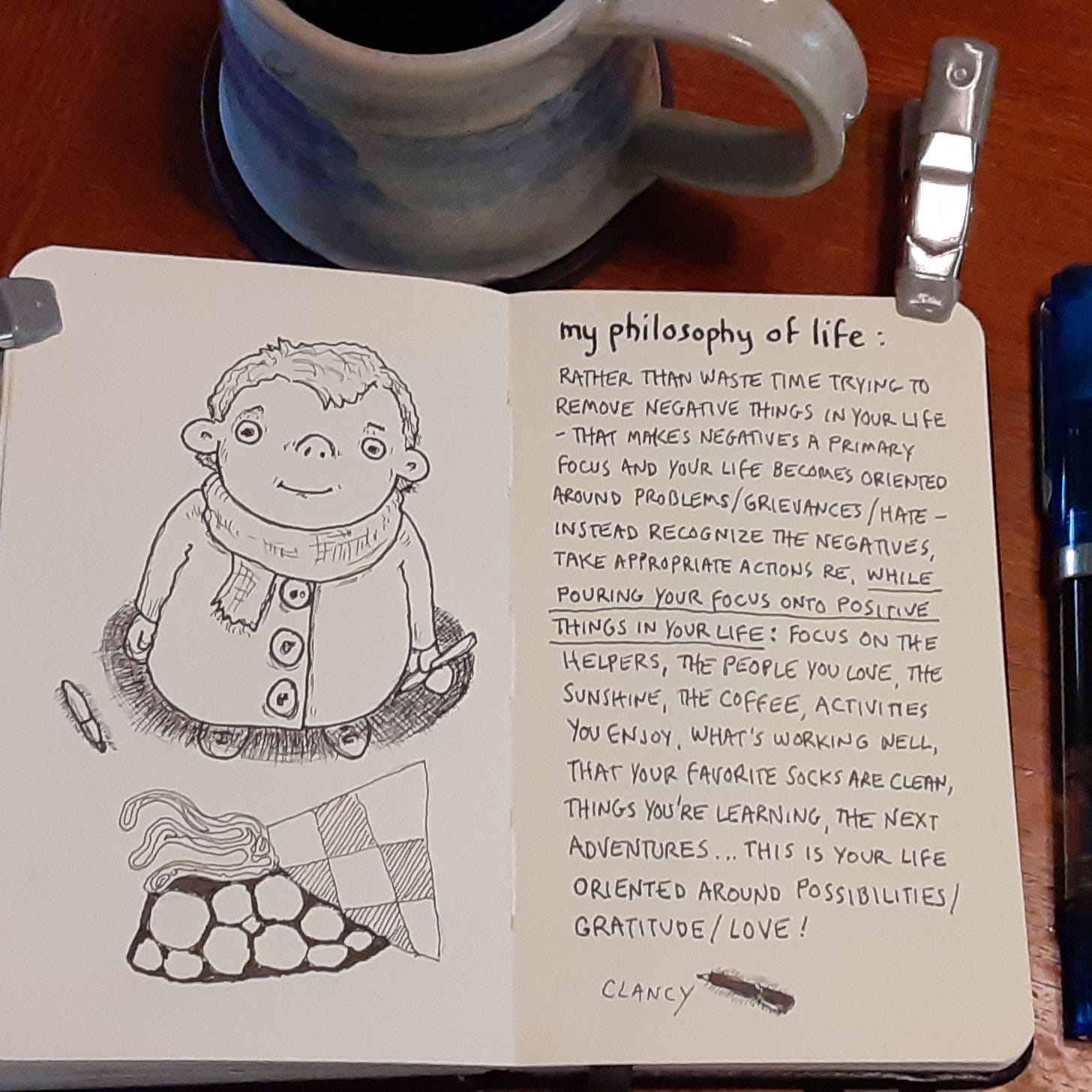
I perked right up at hearing that concept. From my upbringing I still had the baggage of criticism from my religious biologics about being an artist (and gay and deaf) so over time I reframed my own internal story about my art creation – I changed the story from my art creation being a “rebellious act” to my art creation being “an enjoyable thing I like to do”. That sounds like a mild reframing when I describe it now – but it was a beneficial sea change for me.
As is the notion that mental health and self-care aren’t “once and done” events but are an ongoing daily process like cooking and doing the dishes. Realizing that I don’t have to achieve “perfect” mental health and stay there was a relief! All I have to do is do the best I can now and continue to improve. Good enough is good enough.
I can absolutely understand and relate to that. In my own work with my first good therapist, I learned a lot about being gentle with myself, something that I also learned in a somatic/creative way through my craft-as-healing experiences with crochet.
How Crochet Taught Me Gentleness With Myself
I was delighted when I first discovered the @knittingistherapeutic account on Instagram and excited when I realized it was linked to a podcast (Why I Knit) created by a Clinical Psychologist (Dr. Mia Hobbs) who is passionate about the mental health benefits of knitting (and crochet, etc.)
I think it shows how far you’ve come that this now feels like a mild reframing when it was definitely a big thing.
We talk a lot about the benefits of creativity, which is so important, but what about the flip side of that ... have you had experiences where being a working artist challenged your mental/emotional health in ways that didn't feel positive?
When we were still living in Oklahoma and I had my work in art events, I would frequently be on the receiving end of harassment by my biologics and their church. There were many people who were not a part of that church that supported my artwork and my art events but the harassment was so frequent that I found it hard to trust the kind people. That impacted my creativity in multiple ways. One was that I was still doing much of my artwork in defiance of the bullies. Which meant I was still oriented around and reacting to their behavior instead of making my own choices for my own reasons – I was struggling at that time to reframe my creativity (see my reply to your earlier question!) as something I did because it’s enjoyable.
But living in Oklahoma took a toll on my mental health with people making hurtful remarks about “graven images” at almost every art event featuring my artwork. Add to that I was receiving harassment about being gay in the grocery stores and getting discriminated against because of my deafness at some of the restaurants. A few years before we moved out of Oklahoma, I had to stop attending art exhibits in Oklahoma – it was either that or stop making art. And I simply couldn’t stop making art. I also began exhibiting my artwork primarily outside the state of Oklahoma. When we moved (12 years ago now) it took me about a year to recover from the nightmare of living in Oklahoma, to reassure myself that here in the Pacific Northwest I really am safe. We’d hardly been in our new home 3 months when I had a local art exhibit – and it was a blissful event simply because it was all love and no hate!! That’s been true ever since our move – life and work here is just life and work! Our move has been one of the best things I’ve done for my own mental health and my creativity!
It hurts my heart to hear those stories of harassment and warms my heart to hear that you were able to find your right place. I recall when you interviewed me, you had said as part of a question to me:
“When we were thinking about moving I did wonder how the absence of actively struggling against society would affect my artwork. I was glad that you pointed out in your book that creating art is a way to cope with difficulties. It definitely is!”
Many of the stories in Dr. Bob’s book are about how to cope with difficulties. Of the stories that you illustrated in the book, which is the one that resonates most for you right now and why?
The Two Wolves story resonates most because it reminds me to be careful of which of my inner wolves I’m feeding. Seeing the current attacks by religious conservatives on women’s rights, on gay rights, on people of color, on trans rights, on public schools, the abuse of immigrants in Texas and Florida – and the religious based book bans - has sometimes been triggering for me. I can hear too much of the current news and get depressed which doesn’t help my creativity nor does it change that which I’m upset about. However, I know from having illustrated the book by Dr. Bob that it is possible to feel hopeless and still behave in ways (vote, donate etc.) that reflect hope. So, a critical aspect of my creative life is that I try, daily, to feed my good wolf and maintain my hope. I try to feed my joy so it won’t be hungry. I feed my good wolf so I can provide food (via my art) for other good wolves in this world. That’s how I’m fighting injustice.
Oh that is so very powerful. Thank you for doing that and for sharing it as a reminder to us. Focusing on the hope, the good wolf so to speak, must have benefits for your own mental health as well?
The only thing I can control in life is where I put my attention. So I like to pay attention to pleasant things, to kindness and gentleness - not because I want to be a "good person" or because I'm afraid of difficulties - but rather because I know good people and difficulties both exist and need attention. We need to remember that pleasant moments happen constantly or else we can lose hope especially during hard times. So I pay attention to pleasant things as much as I can. It can be a very tiny pleasure, like a particularly good morning coffee, but I like to keep a lookout for these pleasantries. It helps my mental health.
I think a lot of us know the Two Wolves story and it applies to us each in different ways. There’s so much power in storytelling, which is what makes Dr. Bob’s book stand out.
Is there a story many of us might know that's not in the book (something from mythology or literature etc.) that has been particularly helpful for you in terms of emotional health?
The Myth of Sisyphus. It helps me remember to be process oriented rather than outcome dependent. For me the Myth of Sisyphus also relates to the quote by Marcus Aurelius “When you rise in the morning, unwillingly, remember you rise to the work of being human.”
Having some constructive coping methods, good mental health outcomes, developing social emotional learning skills isn’t about achieving perfection, getting a prize or even “finishing” – it’s an ongoing process. Often, it’s an ongoing process of unlearning harmful things taught to you by other people and learning helpful things instead. Every day we’re choosing which wolf to feed.
I love that the two stories relate for you in that way. It also sparked a memory … when I first moved to San Francisco which is, of course, famous for its hills, there was a theatre festival that included a one-person performance that was simply a silent recreation of Sisyphus pushing the rock (I think it was a ball in this case) up the hill and then it rolling back down. I was in my own deep depression at the time, on the verge of getting a diagnosis and help but hadn’t gotten it, yet, and I think the struggle of that piece really stuck with me because of the timing in which I saw it.
At the time, I only felt the hopelessness of it. The “why the heck keep trying to push it up the hill.” But today, from a healthier standpoint, I’m able to see a lot of beauty in being present in the moment with the process, the journey and even the struggle.
What were the biggest joys and challenges of working on this book?
It was a delight and honor to create the illustrations back in the early 1990s and to see my art included in something that helped so many people! In 2012 Dr. Bob asked me to create an e-book and printed book version of my illustrations combined with his lecture notes that he could use in his private practice. That was in the early days of e-books and print-on-demand books – so it was a technical challenge for me to create the e-book especially. Dr. Bob wanted the e-book – and a small slim printed book – because many of his clients in Oklahoma said that they didn’t read much. So, he wanted formats that wouldn’t intimidate the “non-readers” in his client list.
You and I have talked a bit about the combination of words and illustrations as an art form in and of itself and this is a great example of how that art form may reach different people than either one on its own.
I noticed that the second edition of the book had changes in formatting to benefit people with dyslexia ... so curious about that?!
After the first edition of Dr. Bob’s Emotional Repair Program First Aid Kit came out Dr. Bob became aware of the issue dyslexics can have with some font styles in both e-book and print formats. Dr. Bob wanted to remove as many barriers to good mental health as possible for people – and if a barrier could be removed with a change of font, well why not! Dr. Bob died suddenly in 2015. So when, at his widow’s request/encouragement, in 2019 I released a new edition with the one change Dr. Bob had noted within the text before his death, I also made a change to the font and formatting for dyslexics. My wife and I have dyslexics in our family and friend circles – so it was a no-brainer to make that adjustment!
No matter how aware we try to be of accessibility issues, there are always things we may not know or may forget to attend to and I think it’s so great that you were able to see that and make the change.
I loved your article on creative mistakes. One of the things I've found for myself and in interviewing other people is that art/craft can often be a safe place to make mistakes which helps open up something in us that allows for accepting "mistakes" in other areas of our life. Does that resonate for you at all?
It absolutely resonates! For me perfectionism is really toxic – the whole religious purity culture perfectionist bullshit is a horrific part of my childhood upbringing. Being deaf, almost by definition, means missing things people say and thus not being perfect. The religious expectations of women to be “pure” pretty much means we’re not allowed to be human, with human desires or needs. The religious prohibitions on sex, restrictions around gender roles, the “moral panics” about the existence of LGBTQ people …. All of it screams that some people have an unspoken selfish assumption that “things should be as I wish them to be” and “you’re different, I don’t like you, you should change to please me.” It’s an unattainable utopian desire for perfection as defined abstractly by someone else or by their church that they’d like to impose upon the rest of us.
Creating art for me is (now) an ongoing practice of the process of paying attention to what I pay attention to, it’s a process of listening in the quiet spaces between my emotions, my thoughts and the world around me. It’s not about perfection.It’s not even primarily a product anymore. Oh, sure I still make paintings and books – both become physical products of my mind that are displayed and sold via my art galleries – but I’m thinking these days first and foremost that my artwork is about the mind + body + community/world interconnection.
Art is the mental organ that inhales/exhales practical forms of love. Philosophy concerns itself about intangible abstract ideals. Art is about particular examples and is a concrete communal conversation.
And thank you for your kind words about my newsletter edition about mistakes! For me being an artist is not about doing a perfect drawing or painting – it’s about being able to cope well and even repair the mistakes in order to make something as close to what you want to communicate as it can be and also be something that is part of a conversation with other people.
What is one more fun thing that you can share with us?
I’m on Day 282 of the Ray Bradbury Reading Challenge 1000. Bradbury mentions his challenge in his book Zen and the Art of Writing. As per the challenge everyday for the last 282 days I have read one poem, one essay and one short story. I hope to continue this for 1000 days! All three of these, the poem, essay and short story really are short – it takes me perhaps 20 minutes or less per day to read in these three categories. Doing this feeds my muse! It feeds my joy! It feeds my good wolf!
Things to check out:
Copies of Dr. Bob’s Emotional Repair Program First Aid Kit can be found here
You can see more of my current art projects at www.sueclancy.com and http://sueclancy.substack.com. I have a one-person art exhibit coming up in October at the Caplan Art Designs Gallery in Portland Oregon.
Congrats on the exhibit! And on the Bradbury challenge; that sounds like a very inspiring way to add to your own creative well.
Thanks for reading. You might also want to see Sue’s visual interview responses:
If you love what Sue’s doing, subscribe to her Substack:
Check out what Sue shared about me:
If you read this far, perhaps you liked the work. The work does take work. It only continues with support, so please consider subscribing. My annual rate starts at $10 per year.


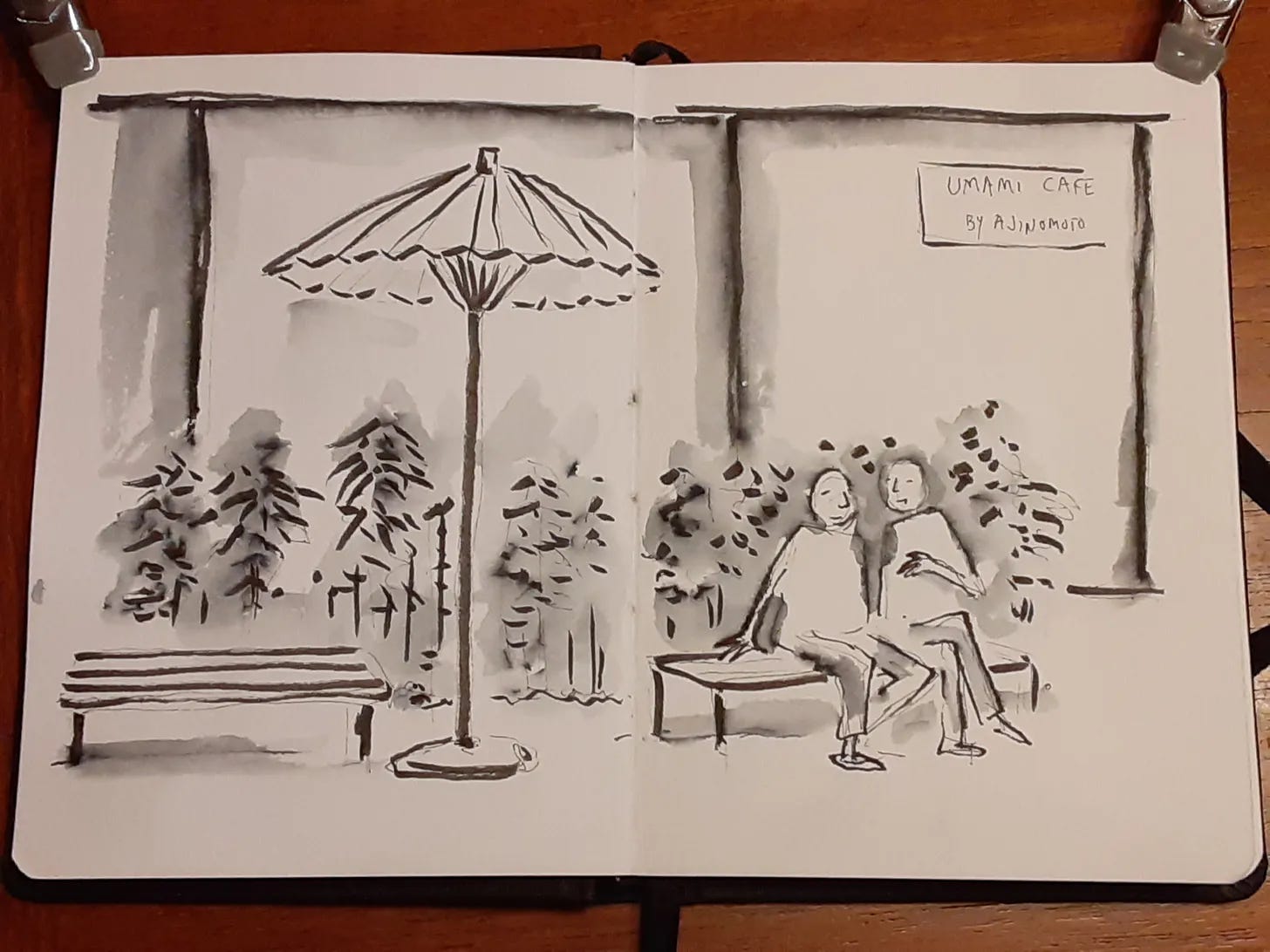
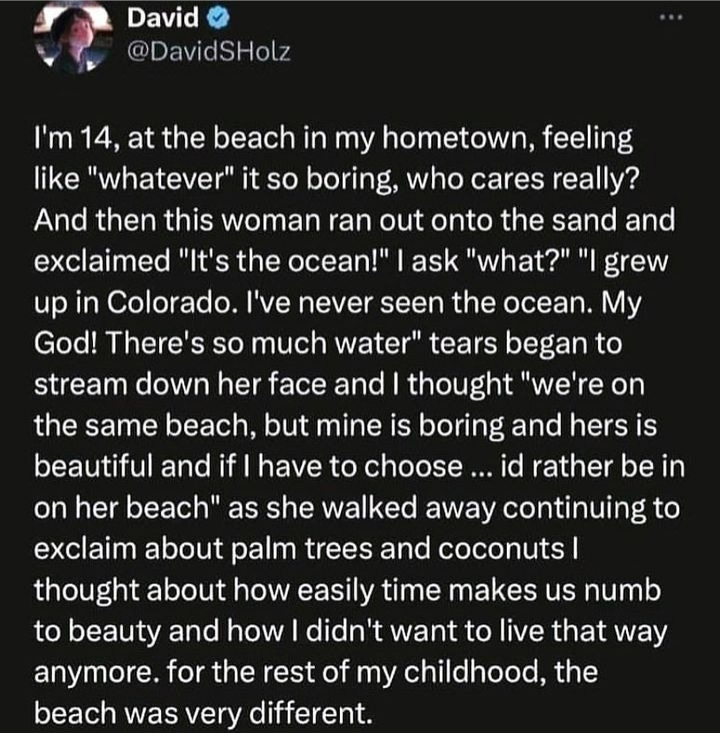
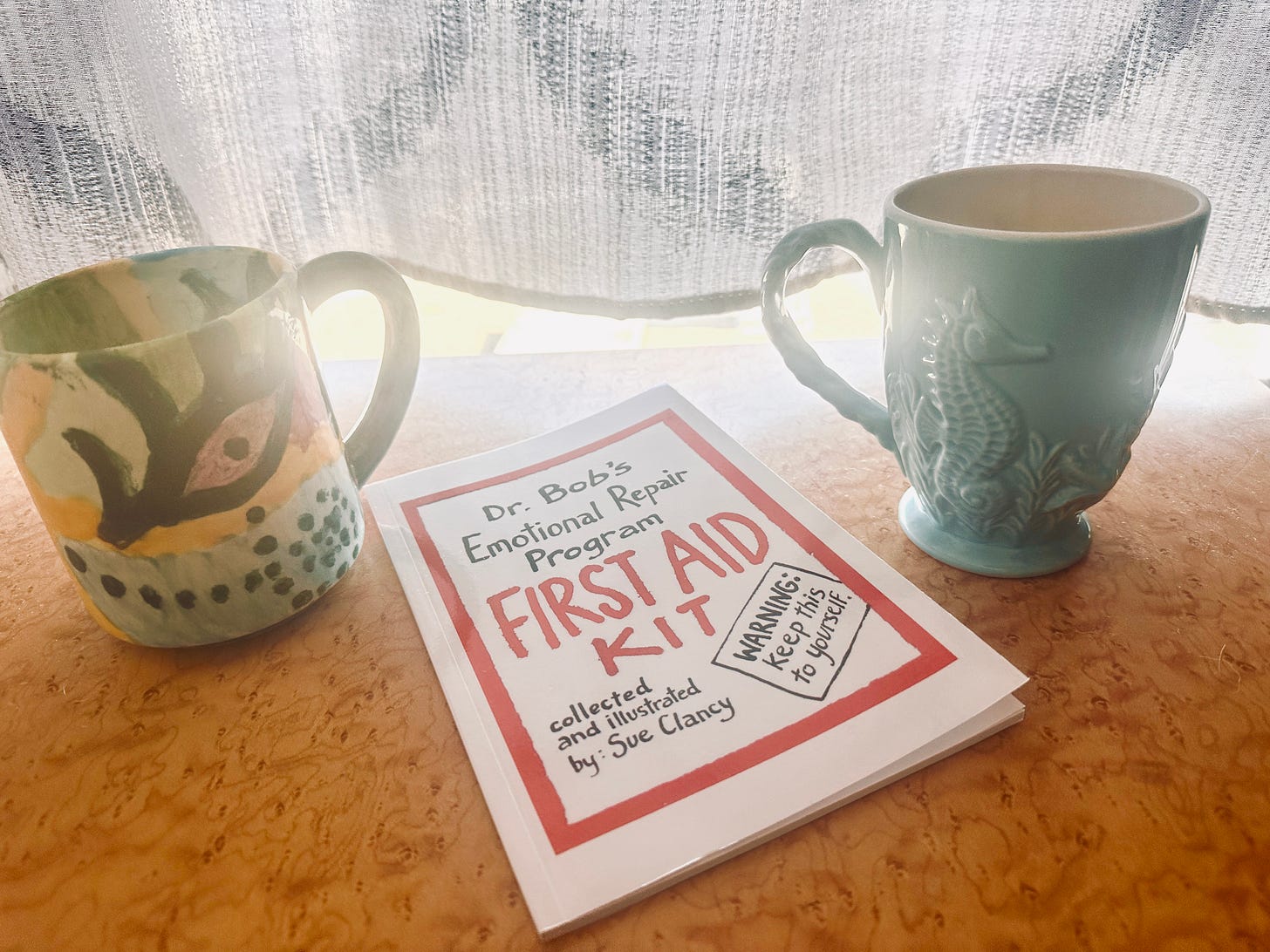
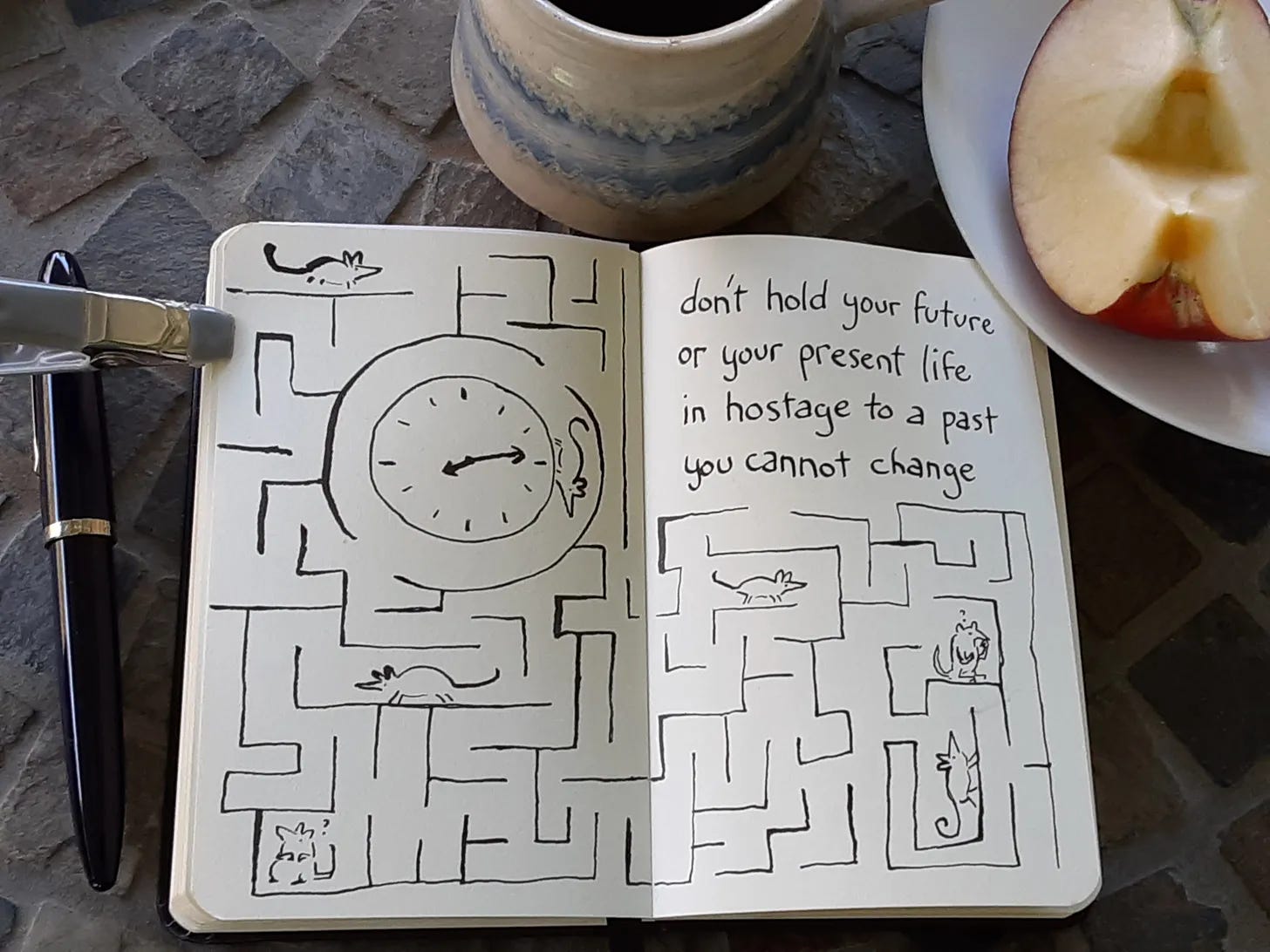
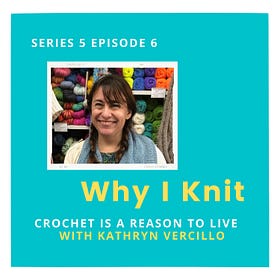
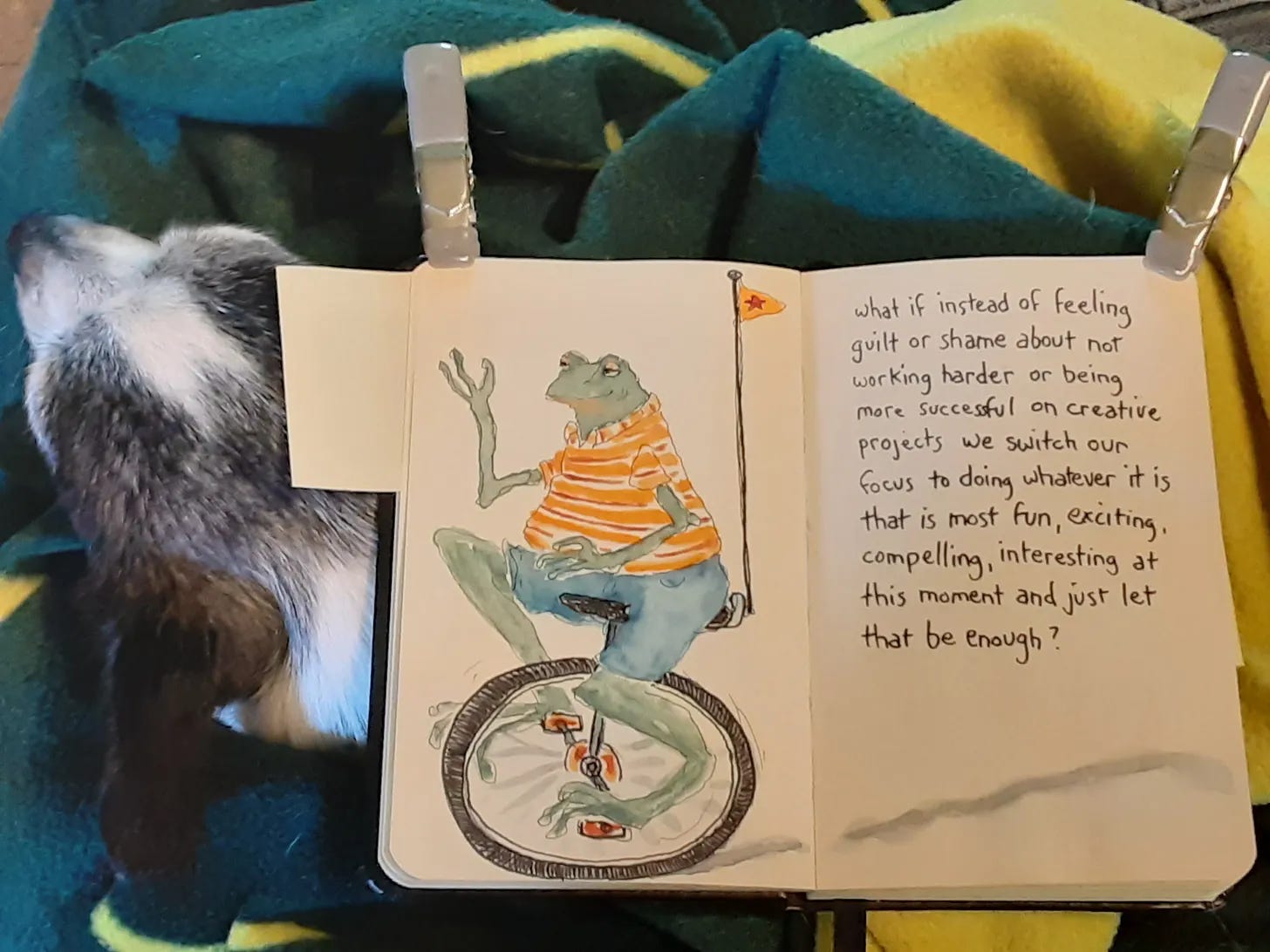
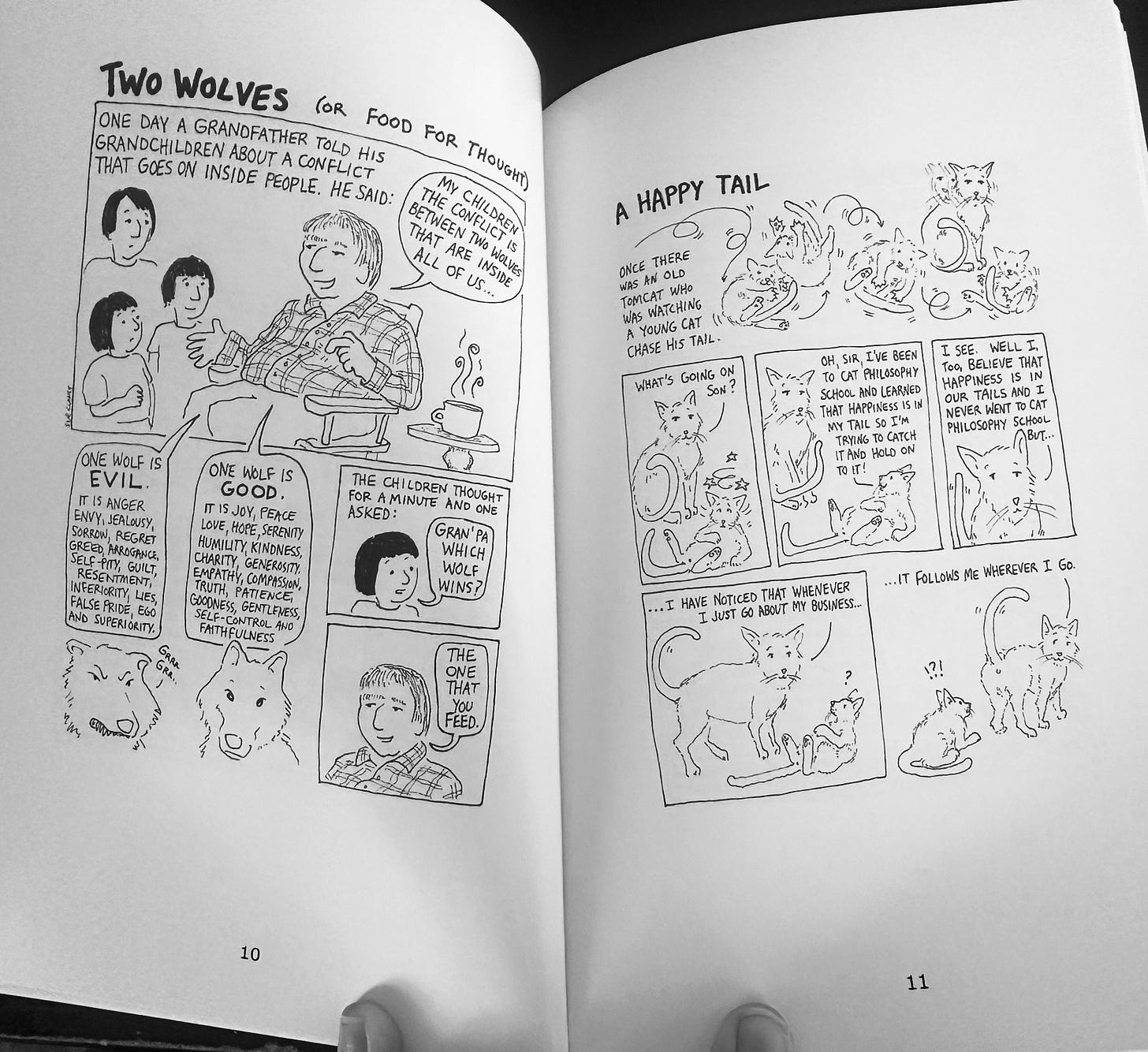
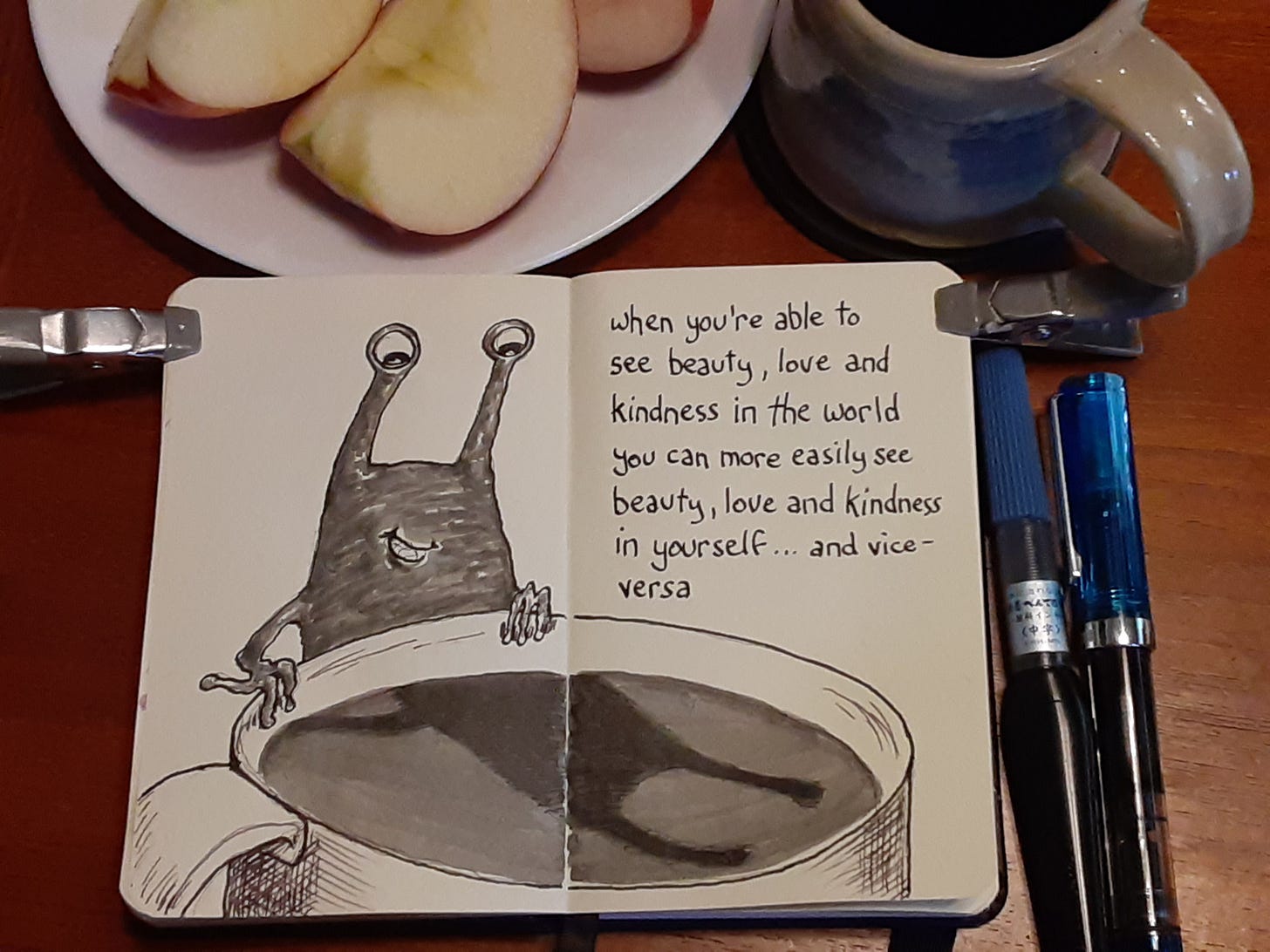
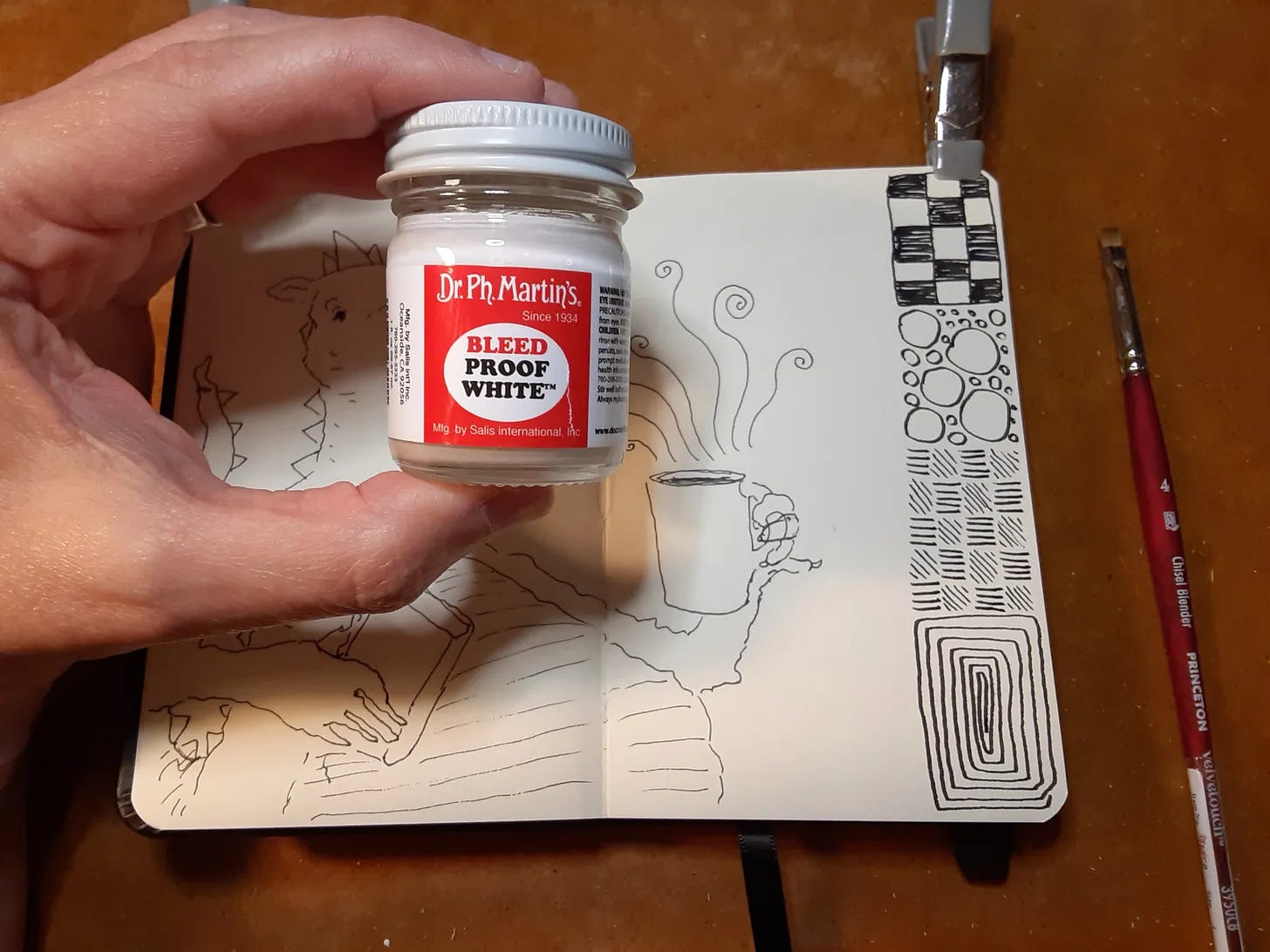
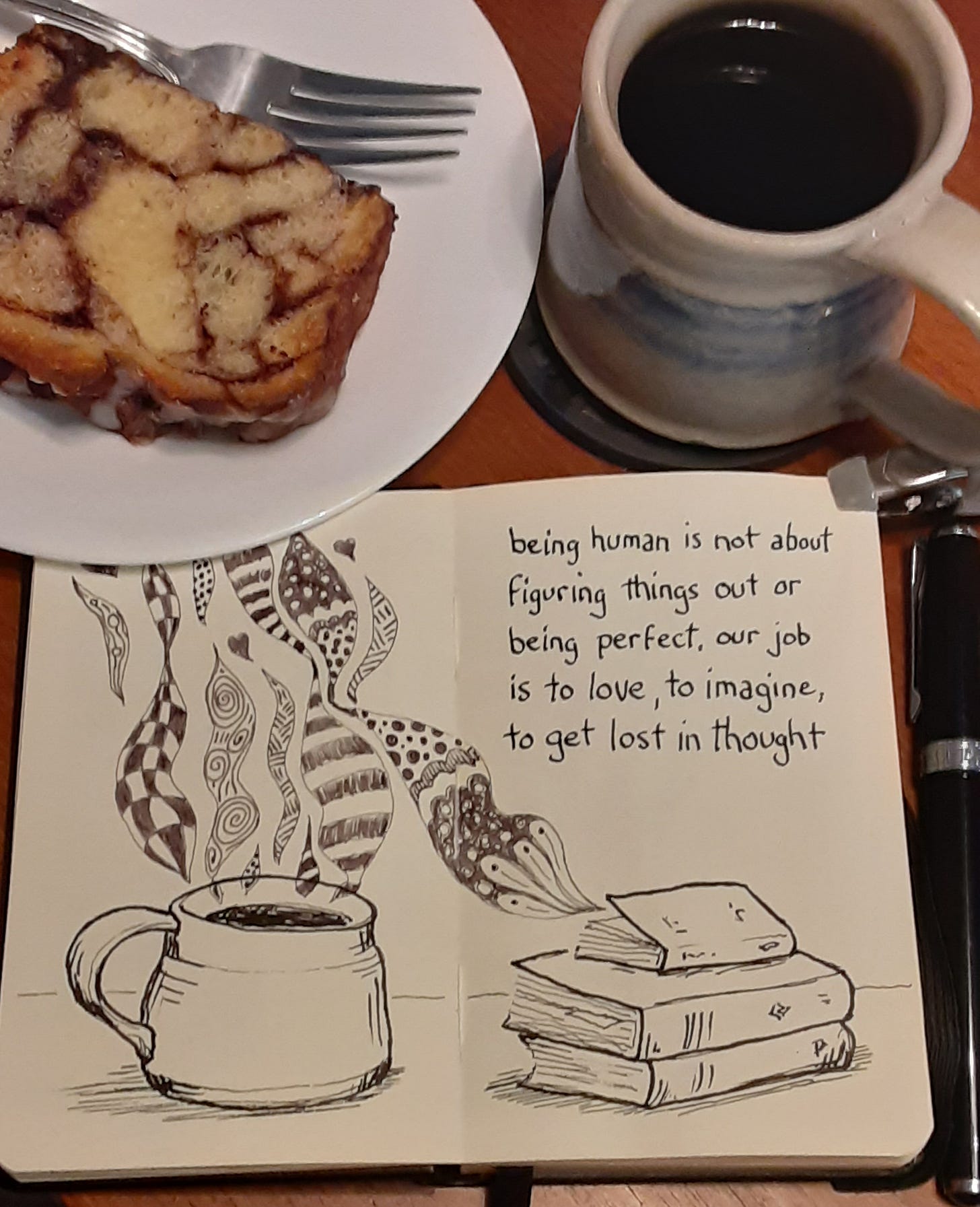
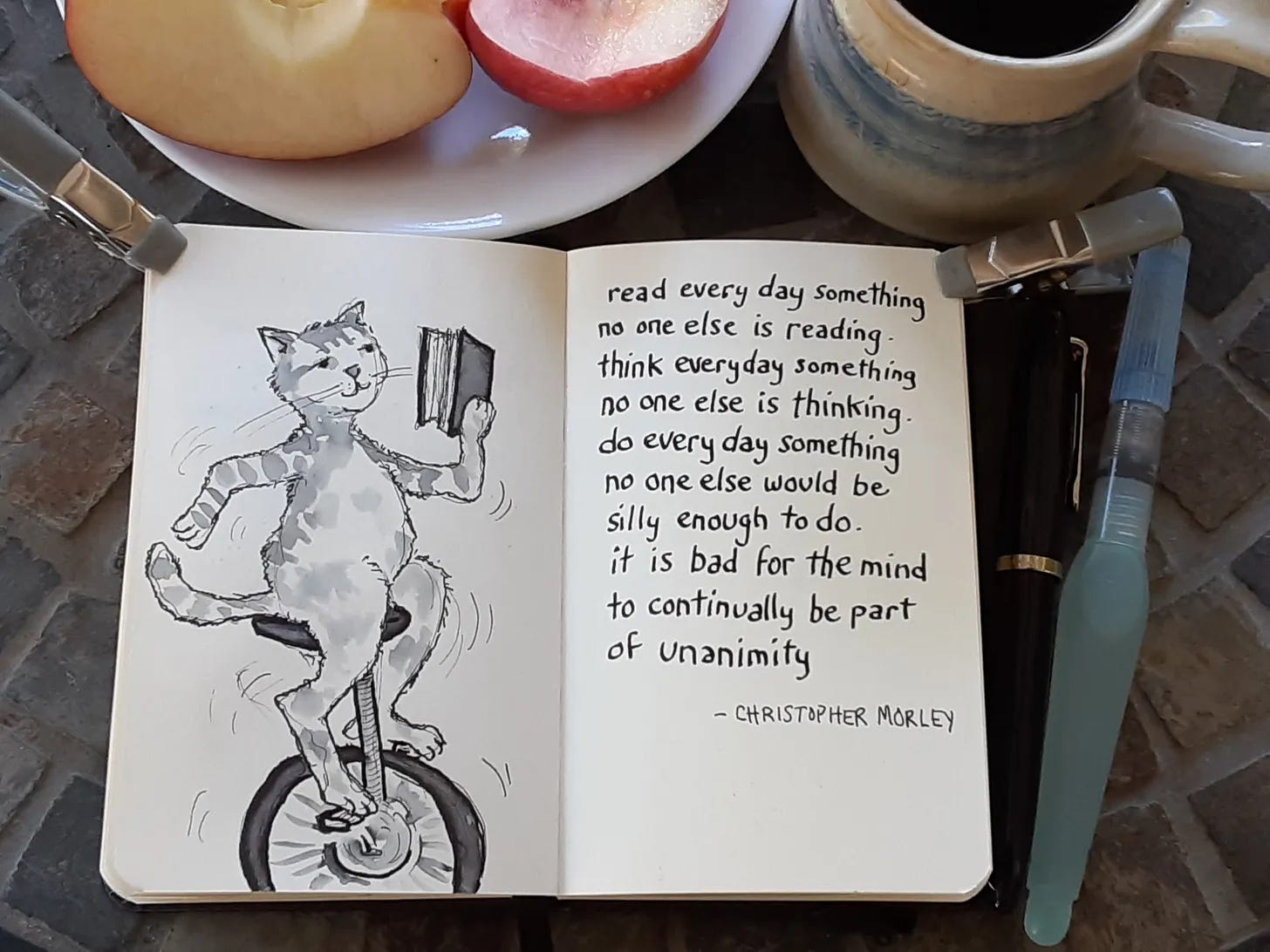



A beautiful conversation with one of my favorite artists and Substackers!
I found the link and ordered the book- thank you both!